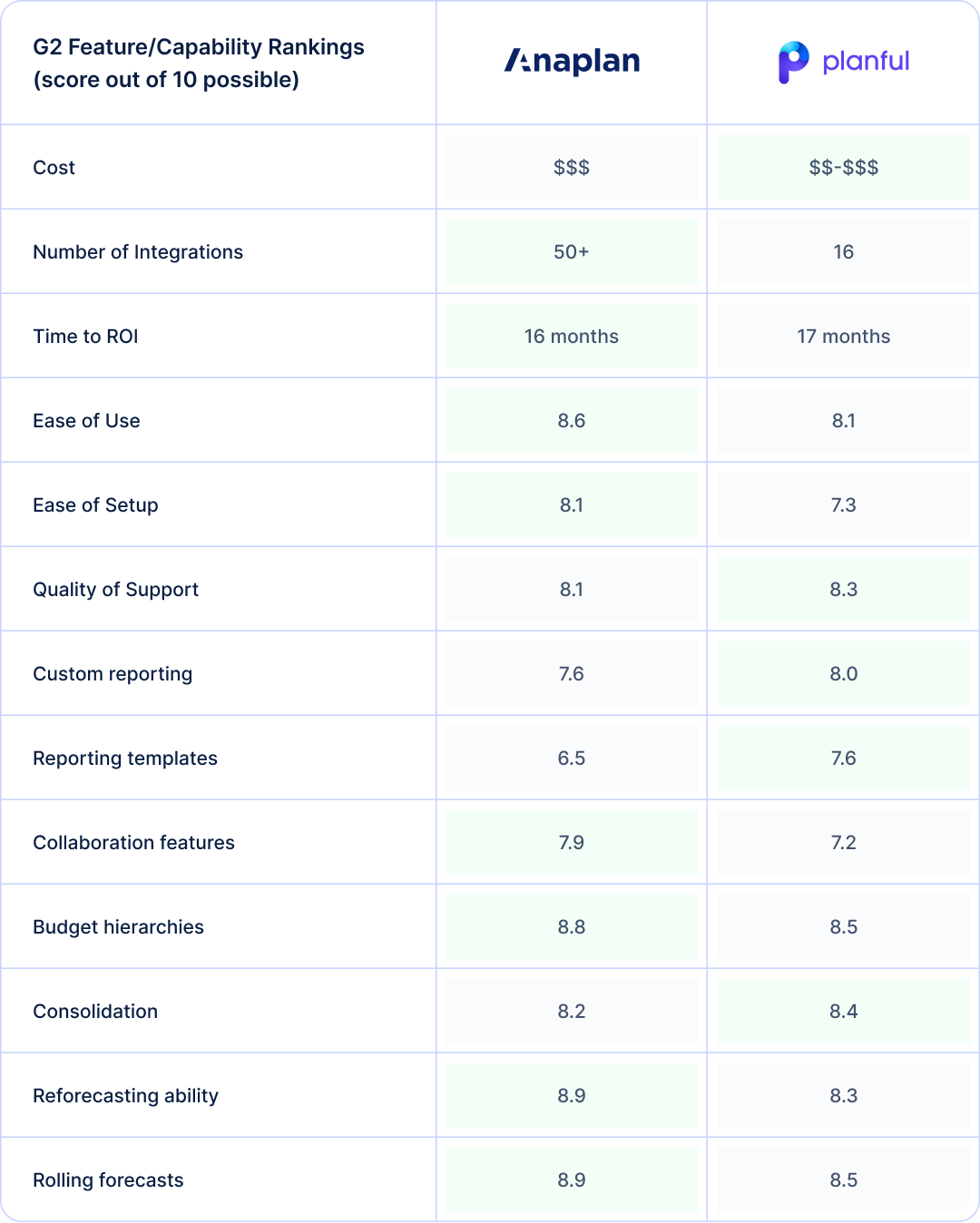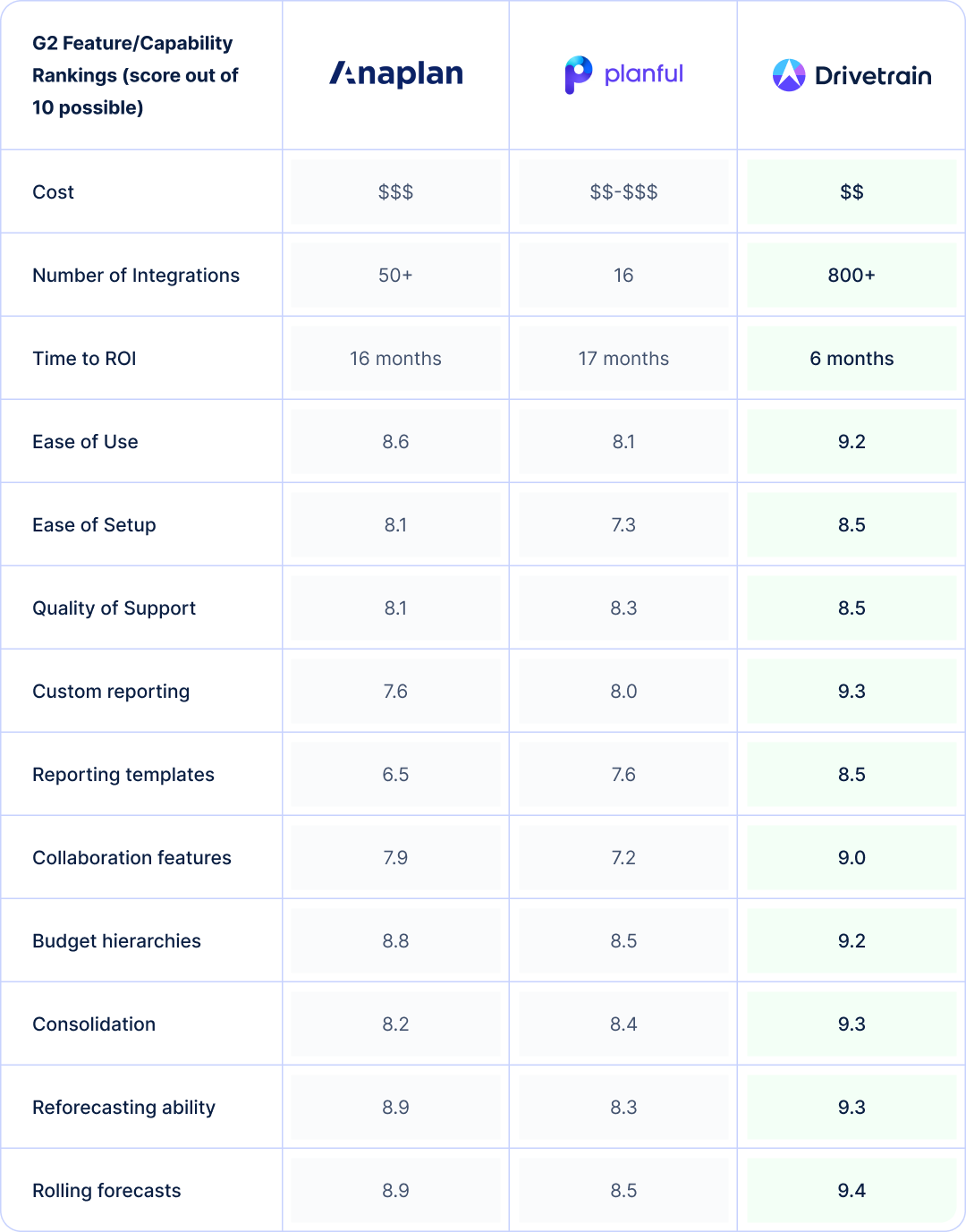Planful vs. Anaplan: Which FP&A platform fits your finance team’s needs? Planful is built for both mid-market businesses and enterprises, while Anaplan caters mostly to enterprises.
In this article, we'll break down when each makes sense, plus why some teams are now looking at newer alternatives like Drivetrain that promise enterprise capabilities without the complexity.
Your forecast just changed. Again. And your CFO wants updated scenarios by the end of the week. This is the state of financial planning and analysis (FP&A) today. Forecasts shift overnight; budgets get slashed mid-quarter. Your FP&A team is expected to move faster than ever with fewer resources and zero room for error.
The automation question is settled. Everyone knows manual spreadsheets don’t cut it for FP&A at scale. The real question of choosing an FP&A software often boils down to, “Which one will actually deliver without adding more work?
Modern finance leaders want tools that deploy fast, work intuitively, and scale without becoming a maintenance nightmare.
Planful and Anaplan are two popular FP&A platforms today. Both promise smarter forecasting, faster month-end close, and stronger collaboration. However, where one platform might be overkill for your team, while the other might not scale when you need it to.
So which one actually fits how your finance team works? Read on to find out.
Evaluating Planful: strengths, weaknesses, best fit
Planful has carved out a niche as a finance-first platform that prioritizes usability and speed over technical complexity. It commonly makes it on the list of options that mid-market businesses explore when they’re ready to move beyond spreadsheet-based planning but don’t want the high overhead commonly associated with enterprise modeling tools.
Users on G2 and Gartner describe Planful as a finance-friendly platform, noting their ability to get up and running faster with Planful than legacy FP&A systems. Planful offers an intuitive interface, streamlined implementation, and out-of-the-box reporting features that can help accelerate budgeting, forecasting, and financial close cycles.
While users appreciate the platform’s intuitive UI, they also note that Planful can impose a steep learning curve for finance teams, particularly those transitioning from Excel. Teams also struggle with Planful’s modeling limitations. As planning models grow more complex with the addition of entities and more dimensions, Planful can start to slow down. Planful limits models to only eight dimensions, perhaps as a way to address this issue. However, businesses wanting to do more advanced scenario modeling and granular driver-based forecasts will need to find creative workarounds to avoid performance issues.
What are Planful's main strengths?
- Value in multi-entity, audit-heavy environments: Planful helps users manage multiple books and compliance across entities, shortening month-end close cycles.
- Breadth across planning and close: Planful offers capabilities that cover budgeting, forecasting, consolidation, and reporting to streamline planning and month-end close processes.
- AI-assisted features: AI-powered features help users actively monitor data for anomalies and catch trends or issues in a timely manner.
What do users cite as Planful’s limitations?
- Performance issues at scale: Planful handles everyday planning well, but it can slow down once models get large or highly detailed. Refreshing data or consolidating multiple entities can take longer as complexity increases.
- Modeling flexibility: Planful’s simplicity is a strength until you need complex modeling involving more than eight dimensions. Users looking to build detailed, driver-based, or multi-scenario forecasts often find its modeling options limited.
- Maintenance effort: As implementations expand, keeping the system running smoothly can take more admin time. Some teams mention needing outside consultants to manage upgrades or troubleshoot performance issues.
- Reporting limitations: While built-in reporting works for standard outputs, users often need to Excel or BI tools for deeper analysis or more customized visuals.
- Integration challenges: Basic data connections are simple. However, integrating it with multiple source systems or complex pipelines can require IT involvement or vendor support.
When does Planful make sense?
Planful can make sense for mid-market businesses with basic needs in terms of budgeting, rolling forecasts, consolidation and close, and who value speed over highly granular modeling.
Given Planful’s limitations on modeling, enterprises with multi-dimensional and/or multi-entity models or finance teams requiring extensive scenario modeling and dynamic “what-if” scenarios may find that Planful cannot meet some of their core planning needs. In these cases, platforms designed for enterprise-scale modeling may deliver stronger flexibility, though often at the cost of higher complexity and longer deployment cycles.
In short, Planful might be a good fit for you if your models aren’t too complex and if you don’t need a highly customized setup. Custom configuration of your system in Planful, especially with integrations and model setup, typically requires the involvement of external consultants or IT specialists, who may also be needed to maintain the model post implementation.
These realities drive your TCO of Planful higher and at the same time, reduce your overall business agility. If you're an enterprise juggling multi-entity consolidations, complex driver-based models, or constant scenario planning across dozens of variables, you probably need to look for an enterprise-grade solution, which brings us to Anaplan.
Assessing Anaplan: power, complexity, best-fit use cases
Anaplan has been around for a long time, and it’s often top of mind when enterprises start looking for a more robust FP&A solution. It is a well-established, legacy player in the FP&A software market, catering to enterprises that need deep modeling power and the flexibility to handle highly complex planning environments.
Anaplan is designed for organizations juggling multiple business units, regions, or product lines and is capable of managing granular, driver-based forecasting at enterprise scale.
That power, however, comes with costly complexity. While Anaplan’s flexibility is one of its biggest strengths, it’s also one of its main challenges. The platform allows you to model almost anything, but it requires a high degree of skill and careful governance to do it well. Many organizations set up internal Centers of Excellence (COE) or must rely on certified partners to manage model development, integration, and ongoing optimization.
This comment from a G2 reviewer echoes others that struggle with this reality, “Without major talent, the models can quickly go awry and be poorly designed. Though the functionality may work, it might be less performant or create complexities when trying to adjust existing logic. Talent is also a large factor when considering this tool as it requires either building a team in house or contracting out.”
If your team has the resources, expertise, and organizational maturity to manage it, Anaplan might be a solid choice. But if you don't, it will quickly become a high-maintenance, costly platform that never quite delivers on its promise.
What are Anaplan's core strengths?
- Powerful modeling engine: Anaplan can handle detailed, multi-dimensional models across geographies, business units, and data types. It’s built for teams that need deep, driver-based forecasting and scenario analysis.
- Enterprise-level flexibility: The platform adapts to many planning domains like finance, sales, operations, and workforce, making it useful for organizations that need unified planning across departments.
- Real-time collaboration: Multiple users can work on the same model simultaneously, with changes reflected instantly.
- Scenario planning capabilities: Finance teams can test different “what-if” cases side by side, helping decision-makers see the impact of assumptions before making major moves.
- Established ecosystem: With a large partner network and certified consultants, enterprises have access to strong implementation and governance support, though at additional cost.
What are the most common limitations noted by users?
- Steep learning curve: Anaplan isn’t something you can “just pick up.” Building models typically requires trained model builders or COE resources, which adds cost and limits flexibility for smaller teams.
- Longer implementation cycles: Getting Anaplan up and running takes time. Deployments can stretch over several months and almost always require support from consultants or partner firms. That means slower time-to-value compared to other modern FP&A platforms.
- Ongoing maintenance load: As models grow, upkeep becomes more complex. Without clear ownership and governance, performance issues or redundant models can emerge over time.
- High total cost of ownership: Between licensing, specialist staffing, and integration costs, Anaplan is one of the more expensive FP&A options. Buyers frequently lament that maintaining it well requires sustained investment.
- Integration overhead: Connecting Anaplan to multiple data systems is possible, but often IT-intensive. Keeping data pipelines clean and updated requires ongoing support.
When does Anaplan make sense?
Anaplan works well when you've got the scale and the support you’ll need to maintain it. It may be a good fit for you if you're running multi-entity models across regions or business units, planning touches multiple functions (finance, sales, supply chain), and scenario modeling is a must. You’ll also need to have either in-house technical expertise or the budget to bring in partners who do.
If you're a lean finance team that needs results now and don’t have resources for dedicated model builders, Anaplan is likely a no-go. But if you're ready to invest in governance, training, and long-term structure, Anaplan can prove to be a complex but capable, albeit costly, planning platform.
Planful vs. Anaplan: a comparison of features and user experience
Choosing between Planful vs. Anaplan often boils down to what kind of finance team you’re running and how much complexity you’re prepared to manage. Both tools are well established in the FP&A space, but they serve very different priorities. Planful excels in usability and speed, while Anaplan offers power and flexibility for large, multi-entity organizations that Planful can’t match.
From user reviews on G2, the biggest advantage to Planful is its accessibility. While it can be tough to learn, Finance teams appreciate being able to configure and run their basic planning cycles themselves without heavy IT involvement. In contrast, Anaplan users value its ability to handle sprawling, multi-layered models across business units, something Planful can’t do at scale. But that flexibility comes at a cost: higher setup times, deeper skill requirements, and heavier administration once it’s live.
Planful users report somewhat shorter implementations than Anaplan and smoother onboarding; Anaplan users report longer timelines but deeper modeling capabilities once everything is in place. In terms of support and customer experience, Planful slightly edges ahead on G2, while Anaplan’s community and partner ecosystem make it more sustainable for enterprises that can afford to invest in in-house expertise.
Both vendors are leaning into AI-driven planning, though at different paces. Planful has started integrating AI for forecasting assistance and anomaly detection, aimed at improving speed and decision confidence for non-technical users. Anaplan, meanwhile, is further along in embedding predictive modeling and scenario simulation into its platform, reflecting its enterprise focus and investment in advanced analytics. For now, Anaplan’s AI capabilities appear to be more robust, while Planful’s are more approachable and easier to adopt.

Anaplan vs. Planful: Where they both fall short for dynamic finance teams
While Anaplan and Planful both offer strong features, they both leave gaps in what they provide for many finance teams operating in today’s fast-paced business environments with rapidly evolving needs.
Implementation challenges and high TCO
A recurring complaint across both user bases is how long the time-to-value is for both Planful and Anaplan. Deployments often run longer than expected. Anaplan, in particular, is well known for its scope creep and consultant lock-in, where implementation success depends heavily on external partners.
Planful faces similar criticism on the mid-market side, with buyers reporting delays due to integration and configuration complexity, especially when connecting multiple ERP or CRM systems.
These drawn-out timelines drive up the total cost of ownership (TCO). Both tools often require ongoing consulting spend or internal specialists to keep the systems optimized, turning what starts out as a capital investment into an ongoing or recurring expense.
For leaner finance teams, this heavy implementation load directly undercuts ROI, especially when faster, more flexible financial planning tools can deliver similar outcomes with a fraction of the effort.
Steep learning curve and limited adoption beyond finance
Both Anaplan and Planful are powerful tools, but that power often comes at the cost of ease of use. Teams describe steep learning curves that delay time-to-value and limit adoption beyond the finance function.
That barrier matters because one of the inherent promises that come with adopting an FP&A software is the ability to collaborate more effectively across your organization. The software you choose should give business partners visibility into their numbers and empower them to plan proactively. When the tools are too complex or technical, the result is limited adoption outside of finance, slower cross-functional collaboration, and a heavier reporting burden on FP&A teams. Instead of democratizing data, these systems often reinforce silos.
Changes require time and specialist support
In fast-moving companies, agility is everything. But both Anaplan and Planful make adapting to change harder than it should be. Users across review platforms say even small structural updates, like adding a new business unit or changing reporting hierarchies, can require IT support or external consultants. This dependency slows down decision-making.
How Drivetrain outperforms Anaplan and Planful
Planful and Anaplan are established players for a reason. But finance teams in 2026 are starting to ask different questions.
- How quickly can we deploy this software?
- Do we have to rely on a consultant to make changes to our model?
- Can the platform keep up when the business pivots overnight?
These evolving needs highlight where traditional platforms fall short. Modern finance teams require financial planning software that is fast to roll out, simple to manage, and built to grow with their business.
Drivetrain is an AI-native FP&A software that meets all of these needs with a powerful architecture built on modern technologies to provide enterprise-grade performance and control with the ease of use finance teams need. This is a balance that legacy FP&A tools still struggle to achieve. Drive AI takes these capabilities further, leveraging AI to help users build models faster, uncover insights automatically, and ask questions in plain language to get instant answers.
“With Drivetrain, the sky is the limit. If you can think it, you can build it. You can bring in data from so many different places and having all that data in one place is incredibly valuable. The team is also incredible. They have been incredibly responsive and helpful, not just during initial implementation, but beyond.” — G2 reviewer

Addresses the implementation gap
Drivetrain has implementation dialed-in. Its finance-friendly design and simplified configuration mean teams can get up and running without costly consulting or heavy IT involvement. Pre-built templates give finance teams a head start while still allowing plenty of flexibility for customization.
The difference shows up in timelines. While Anaplan and Planful often take over a year to reach ROI, Drivetrain customers report measurable returns in as little as six months.
“I highly recommend Drivetrain for anyone looking to implement an FP&A tool or a tool which easily consolidates data! The ease of implementation was top notch! Drivetrain is used by our team daily for planning, reporting and modeling.” — G2 reviewer
In addition, support at Drivetrain doesn’t end after implementation. Drivetrain provides dedicated customer success managers, self-guided training, and AI-assistants built into the platform to help users learn while they’re using it. All of this reduces friction, eliminates any dependency on consultants, and keeps finance teams focused on outcomes instead of setup.
Shortens the learning curve and makes collaboration easy
One of Drivetrain’s biggest differentiators is how easily both finance and business users can adopt it. Its spreadsheet-like interface feels familiar from day one, and its built-in collaboration tools make it easy to work across the entire organization.
It’s easy for non-finance users to explore data, run scenarios, and view real-time dashboards without having to go through finance for every update. Drivetrain’s AI copilots also simplify analysis. Users can ask questions in plain language and get immediate answers, removing barriers between people and their data. The result is the true democratization of planning, where decision-makers across the organization share a single source of truth.
“Drivetrain is really allowing the business to get their own data. Not all people within the company, but all the departments are in Drivetrain and using it. It’s just more transparent and everyone's looking at the same data.” — Alison Gillespie, Director of FP&A at Teikametrics
Simplifies ownership and maintenance
Drivetrain eliminates the specialist dependency that slows progress and eats into the ROI for Anaplan and Planful users to dramatically reduce the TCO while enabling finance teams to stay independent and responsive. Finance teams can make structural or logic changes on their own without any need for consultants, coding, or IT support,
Its intuitive AI model builder allows users to adjust dimensions, hierarchies, and formulas in real time, ensuring the system evolves as fast as the business does. Combined with AI-driven guidance and automated data syncs, Drivetrain keeps your financial planning agile and low-maintenance.
As one G2 Reviewer put it, “From sales to proof of concept and through implementation, the folks at Drivetrain provided outstanding support and education. It was one of the best implementations I've experienced with any vendor. I was also impressed by how quickly we were able to start generating valuable financial reporting in a far more digestible & customizable format than QuickBooks offers us. The depth under the hood here is impressive, and the visualizations and UI are leagues above the other tools we researched.”
A decision framework for CFOs
When choosing between Planful, Anaplan, and Drivetrain, CFOs should consider the following three factors:
1. Team size and technical resources
- Planful is best for smaller teams or those with limited IT support.
- Anaplan can be well-suited to larger teams with technical resources.
- Drivetrain is the best fit for mid-market companies and enterprises that want ease of use, agility, and enterprise-scale power with the need for external consultants.
2. Complexity of planning needs
- Planful works well for standard budgeting and forecasting.
- Anaplan excels with complex, multi-departmental planning.
- Drivetrain offers dynamic AI-powered forecasting and insights driven by a powerful calculation engine under the hood, for complex, multi-dimensional analysis and planning.
3. Growth trajectory
- Planful offers stable growth.
- Anaplan supports organizations anticipating expansion.
- Drivetrain is best for fast-growing mid-market businesses and enterprises looking for a flexible, agile AI-powered financial modeling platform.
Ready to choose your FP&A partner?
When selecting the right FP&A tool, Planful can be a good fit for companies with leaner financial processes and smaller teams. For enterprises that require robust, cross-functional planning capabilities, Anaplan delivers the depth and flexibility needed for complex forecasting and integration. However, when comparing Planful vs. Anaplan and Drivetrain, for mid-market companies and enterprises seeking a scalable, intuitive AI-native FP&A platform, Drivetrain is the ideal choice, offering the best balance of performance and ease of use.

Want to see Drivetrain in action? Book a demo today to see how Drivetrain can streamline your FP&A process.
Frequently asked questions
The implementation timeline for Planful is typically 5–6 months while Anaplan can take 6–12 months and sometimes more for especially complex setups. Both platforms rely on consultants, and timelines often extend beyond initial estimates. In contrast, Drivetrain’s implementation process lasts for 4-6 weeks.
Planful’s simplicity can start to feel limiting if your planning starts to become complex. Its eight-dimension ceiling and performance slowdowns at scale make deeper modeling difficult.
As an AI modeling software, Drivetrain solves this by supporting unlimited dimensions, enabling teams to expand models freely without hitting structural or performance barriers.
Both FP&A platforms have a reputation for costs that can add up quickly. Planful and Anaplan hit you with charges for extra storage, larger models, consultant hours, and renewal increases. Users regularly report sticker shock as usage grows.
No. They're built differently.
- Anaplan can handle complicated, multi-layered models, but you need expert builders or a dedicated team to manage them.
- Planful maxes out at eight dimensions, which works fine for standard budgeting but gets tight when your business grows or your models get more detailed.
Drivetrain doesn't limit the number of dimensions you use in your model. It doesn’t need to because its modeling engine is built for scale on modern technologies. You can build as many layers as you need without needing specialists to maintain them.
Anaplan usually needs trained model builders or a Center of Excellence (COE) to manage updates and maintain performance over time. Planful can be owned by finance, but complex models may still require occasional assistance from IT or consultants.
Both vendors introduced new AI features in 2024–2025, but users say they’re still early-stage and focused on surface-level automation.
Finance teams continue to look for clear ROI and ways they can effectively use AI now. They’re finding it in Drivetrain, an AI-powered FP&A platform designed with practicality in mind. Drivetrain helps users build models faster, ask data questions in plain language, and surface real insights instantly.
Drivetrain combines what finance teams like about both tools—enterprise-grade capabilities with a fast, low-friction experience. It offers quick implementation and AI that actually helps users work smarter.
This G2 reviewer summed it up well, “My overall experience with Drivetrain has been great. The tool is extremely easy to use and very intuitive. Producing new reports is seamless and user friendly.”
Drivetrain makes the migration process smoother from Planful, Anaplan, or any other financial modeling software with the below capabilities:
- High-touch onboarding for personalized support
- A dedicated customer success manager to guide the transition
- A library of flexible templates to help teams quickly rebuild models
- A comprehensive knowledge base and self-guided training, enabling finance users to learn and adapt at their own pace.

.svg)






.webp)



.svg)

